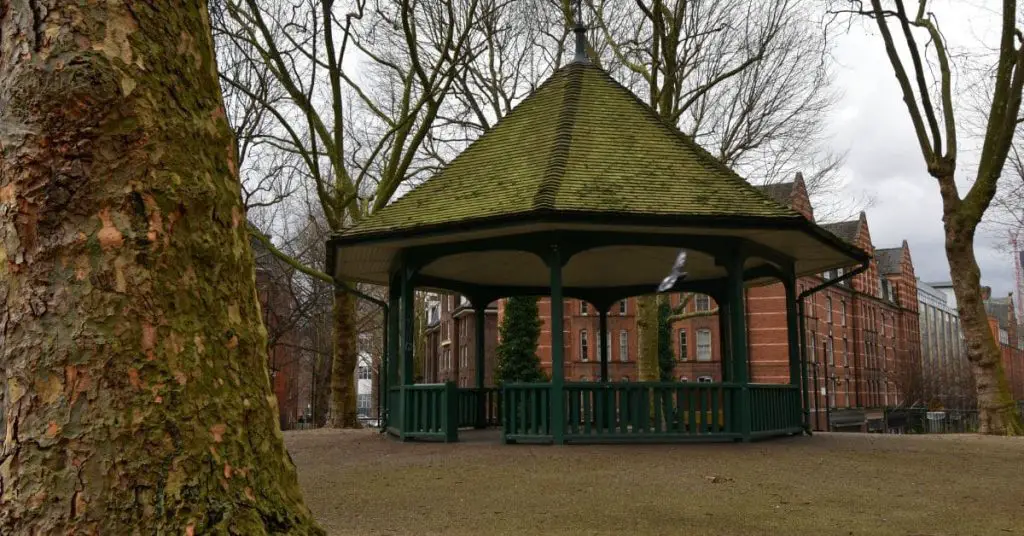I’m excited to share my knowledge and experience with you about caring for and maintaining gazebos. As a gazebo owner myself, I know firsthand how important it is to keep your outdoor structure in good condition so that it can be enjoyed for years to come.
Whether you use your gazebo for entertaining guests, hosting outdoor events, or just relaxing in your backyard, it’s crucial to keep it well-maintained. Neglecting your gazebo can lead to deterioration, rotting, and other problems that could be costly to repair or replace.
In this guide, I’ll provide you with some essential tips and tricks for keeping your gazebo in top shape, including regular cleaning, inspection, and maintenance tasks. With a little effort and attention, you can ensure that your gazebo remains a beautiful and functional addition to your outdoor living space. Let’s get started!
Care and maintenance of gazebo: To ensure your gazebo’s longevity and appeal, regular care and maintenance are essential. Clean it periodically to remove debris, inspect for any damage, and apply weather-resistant coatings. Proper upkeep guarantees a beautiful and functional space for years to come.
Importance of care and maintenance of gazebo

Taking care of gazebos is important for their durability and usefulness. Gazebos provide a nice outdoor area for people to relax and have fun. However, exposure to weather elements like sun, rain, and wind can damage gazebos over time.
Maintenance is crucial for gazebos to last long and avoid expensive repairs or replacements. Neglecting them can lead to damage such as rot, mold, rust, or pests, compromising their structure and beauty.
Regular maintenance ensures the safety of gazebos. Inspections can identify and fix issues like loose or broken parts, sharp edges, or unstable structures that could harm people using them.
Well-maintained gazebos also add value to your property. They enhance your home’s appearance and create an inviting outdoor space for relaxation and entertainment. Neglecting them can detract from your property’s overall beauty.
To sum up, caring for gazebos is essential for their durability, safety, and appearance. By investing time and effort into regular maintenance, you can enjoy your gazebo for years to come and increase the value of your property.
Cleaning the Gazebo
A gazebo is a beautiful and functional addition to any outdoor space, but regular cleaning is necessary to maintain its appearance and durability. Cleaning your gazebo does not have to be a daunting task. By following these step-by-step instructions, you can clean your gazebo effectively and efficiently.
Step 1: Remove Debris
Before cleaning your gazebo, it’s essential to remove any debris or clutter from the structure. This includes fallen leaves, twigs, dirt, and any other objects that may be on or around the gazebo. Use a broom or leaf blower to clear away the debris, and discard it in a trash bag.
Step 2: Prepare Cleaning Solution
Next, prepare a cleaning solution by mixing a mild detergent with water in a bucket. You can also use a commercial cleaning solution specifically designed for outdoor furniture. Avoid using harsh chemicals or abrasive cleaners that may damage the surface of the gazebo. Follow the manufacturer’s instructions for any commercial cleaning products.
Step 3: Wet Gazebo
Using a garden hose or a bucket of water, wet the entire gazebo. Wetting the structure before applying the cleaning solution will help loosen any dirt or grime that may have accumulated on the surface.
Step 4: Scrub with Brush
Dip a soft-bristled brush into the cleaning solution, and use it to scrub the entire surface of the gazebo. Start at the top and work your way down, paying particular attention to any areas that are particularly dirty or stained.
Use a circular motion to scrub the surface, and apply additional cleaning solution as needed. Be sure to scrub the underside of the roof and any other hard-to-reach areas.
Step 5: Rinse Gazebo
After scrubbing the entire surface of the gazebo, rinse it thoroughly with clean water. Use a garden hose or a bucket of water to remove all traces of the cleaning solution.
Be sure to rinse the underside of the roof and any other hard-to-reach areas as well.
Step 6: Dry Gazebo
Allow the gazebo to air dry completely. Avoid using towels or other absorbent materials to dry the structure, as they may leave behind lint or residue. Depending on the weather conditions and humidity levels, it may take several hours for the gazebo to dry completely.
Step 7: Inspect Gazebo
After the gazebo has dried completely, inspect it for any damages or signs of wear and tear. Look for cracks, chips, or any other damage that may need to be repaired. If you notice any damages, address them promptly to prevent further damage.
Step 8: Apply Protectant
Applying a protectant can help to keep your gazebo looking great and protected from the elements. Depending on the type of material your gazebo is made of, there are different protectants you can use.
For wood gazebos, you can use a wood sealant or wood preservative to protect the wood from weathering and moisture. For metal gazebos, you can use a rust-inhibiting spray to prevent rust and corrosion. Follow the manufacturer’s instructions for any protectants you use.
Step 9: Maintain Regular
Regular maintenance is key to keeping your gazebo looking great and lasting for many years. Plan to clean your gazebo at least twice a year, or more often if it is exposed to particularly harsh weather conditions or heavy use. Be sure to address any damages or repairs promptly to prevent further damage.
Cleaning your gazebo may seem like a daunting task, but by following these step-by-step instructions, you can keep your gazebo looking great and in excellent condition for years to come. Regular maintenance and care will help to ensure that your gazebo remains a beautiful and functional addition to your outdoor space.
Maintaining the Gazebo

A gazebo is a beautiful and functional addition to any outdoor space, providing a relaxing space to enjoy the outdoors. However, to ensure your gazebo lasts for years to come, it’s essential to properly maintain it. Here is a step-by-step guide for maintaining your gazebo:
Step 1: Inspect the Gazebo
Inspect your gazebo regularly to ensure there are no damages or signs of wear and tear. Look for any cracks, chips, or rust, and address any issues promptly to prevent further damage.
Step 2: Clean the Gazebo
Regular cleaning is essential to maintain the appearance and durability of your gazebo. Follow the steps outlined in the “Cleaning the Gazebo” guide to clean your gazebo effectively.
Step 3: Check for Loose or Damaged Parts
Check for any loose or damaged parts of the gazebo, such as screws or bolts. Tighten any loose parts and replace any damaged parts promptly to prevent further damage.
Step 4: Lubricate Moving Parts
Lubricate any moving parts of the gazebo, such as hinges, with a silicone lubricant. This will help to keep the parts moving smoothly and prevent them from becoming stuck or rusted.
Step 5: Apply a Protective Coating
Apply a protective coating to your gazebo to protect it from the elements. Depending on the material your gazebo is made of, there are different types of protective coatings you can use. For wood gazebos, you can use a wood sealant or wood preservative to protect the wood from weathering and moisture.
For metal gazebos, you can use a rust-inhibiting spray to prevent rust and corrosion.
Step 6: Check for Water Damage
Check for any signs of water damage, such as mold or rotting wood. If you notice any signs of water damage, address the issue promptly to prevent further damage. This may include repairing leaks or replacing damaged wood.
Step 7: Check for Insect Infestations
Check for any signs of insect infestations, such as termites or carpenter ants. If you notice any signs of an infestation, address the issue promptly to prevent further damage. This may include treating the affected areas with insecticides or calling a professional exterminator.
Step 8: Trim Surrounding Trees and Plants
Trim any trees or plants surrounding the gazebo to prevent branches and leaves from falling onto the structure. This will help to prevent damage and reduce the amount of debris that accumulates on the gazebo.
Step 9: Remove Snow and Ice
If you live in an area with snow and ice, it’s important to remove any accumulation from the gazebo. This will prevent the weight of the snow and ice from causing damage to the structure. Use a snow shovel or broom to remove the snow and ice.
Step 10: Cover or Store the Gazebo During Winter Months
If you live in an area with harsh winters, it’s a good idea to cover or store the gazebo during the winter months. This will help to protect the structure from snow, ice, and other harsh weather conditions. You can use a gazebo cover or store the gazebo in a garage or shed.
Maintaining your gazebo may seem like a daunting task, but by following these steps, you can keep your gazebo looking great and in excellent condition for years to come. Regular maintenance and care will help to ensure that your gazebo remains a beautiful and functional addition to your outdoor space.
How to stain or paint a gazebo?

Staining or painting a gazebo is a great way to enhance its appearance and protect it from the elements. Here are some steps to follow:
Clean the gazebo: Before you start staining or painting, it’s important to clean the gazebo thoroughly. Use a pressure washer or a garden hose to remove any dirt, debris, or mildew from the surface. Allow the gazebo to dry completely.
Prepare the surface: If your gazebo has been previously stained or painted, you will need to remove the old finish using a paint stripper or sandpaper. If the surface is rough or uneven, sand it with fine-grit sandpaper to smooth it out.
Apply the stain or paint: Using a brush or sprayer, apply the stain or paint evenly to the surface of the gazebo. Be sure to work in small sections, and apply the finish in the direction of the grain. For best results, apply two coats of stain or paint, allowing each coat to dry completely before applying the next.
Allow the finish to dry: Once you have applied the final coat of stain or paint, allow the gazebo to dry completely before using it. This will usually take 24-48 hours, depending on the weather conditions.
Maintain the finish: To keep your gazebo looking great, it’s important to maintain the finish. Check the gazebo regularly for signs of wear or damage, and touch up any areas as needed. You may need to reapply the stain or paint every 2-3 years, depending on the weather conditions in your area.
Remember to follow the manufacturer’s instructions when applying stain or paint to your gazebo, and wear protective clothing and eyewear to avoid contact with the finish. With proper care and maintenance, your stained or painted gazebo will provide a beautiful and functional outdoor space for years to come.
Seasonal Care Tips for Your Gazebo
Seasonal care for a gazebo depends on the materials it’s made of and the climate in your area. Here are some general tips for taking care of your gazebo throughout the seasons:
Spring care
During the spring, it’s a good idea to inspect your gazebo for any damage that may have occurred over the winter. Check for cracks in the wood or metal and repair any damage as needed.
You can also wash your gazebo with a block of mild soap and water to remove any dirt or debris that has accumulated over the winter.
Summer care
During the summer months, it’s important to protect your gazebo from the sun and moisture. If your gazebo is made of wood, consider applying a coat of sealant to protect it from the sun’s UV rays and rain.
If your gazebo has fabric canopies or curtains, make sure to remove them during heavy rain or wind storms to prevent damage.
Fall care
As the weather cools down, it’s important to prepare your gazebo for the winter. Make sure to remove any debris or leaves that have accumulated on the roof or in the corners of the gazebo. You may also want to consider storing any cushions or other fabric accessories inside to prevent them from getting wet or damaged.
Winter care
During the winter months, it’s important to protect your gazebo from the snow and ice. If your gazebo is made of wood, make sure to cover it with a tarp or other protective covering to prevent moisture from seeping in. If your gazebo has a metal frame, make sure to remove any snow or ice that accumulates on the roof to prevent damage.
By following these seasonal care tips, you can help ensure that your gazebo stays in good condition and provides a comfortable and enjoyable outdoor space for years to come.
What kind of weather conditions are best for using a gazebo?

A gazebo is typically used for outdoor gatherings or events, so the best weather conditions for using a gazebo are usually those that are mild and pleasant. Here are some weather conditions that would be ideal for using a gazebo:
Sunny weather: A sunny day with a gentle breeze is perfect for using a gazebo. The gazebo provides shade, so you can enjoy the outdoors without being directly in the sun.
Mild temperatures: Moderate temperatures with low humidity are ideal for using a gazebo. This will allow you and your guests to be comfortable without feeling too hot or too cold.
Calm winds: A gazebo is designed to provide shelter, but it can be difficult to use in windy conditions. Avoid using a gazebo on a day with strong winds, as it can become unstable and unsafe.
Dry weather: While a gazebo can provide some protection from rain, it’s best to avoid using it on a day with heavy rainfall. It’s also important to note that prolonged exposure to moisture can damage the structure of the gazebo.
Overall, the best weather conditions for using a gazebo are those that are mild, calm, and dry.
FAQS
Q.1 What is the best way to clean my gazebo?
The best way to clean your gazebo depends on the material it’s made of. For wood gazebos, use a mild soap and water solution to gently clean the surface. For metal or vinyl gazebos, you can use a garden hose to rinse off any dirt or debris.
Q.2 Do I need to seal or stain my wood gazebo?
Yes, it’s a good idea to seal or stain your wood gazebo to protect it from the elements. Apply a sealant or stain every 2-3 years, or as needed.
Q.3 How do I protect my gazebo from the sun?
If your gazebo is in direct sunlight, consider applying a coat of sealant or stain to protect the wood. You can also add curtains or shades to provide additional shade and protect the gazebo from UV rays.
Q.4 What should I do if my gazebo is damaged?
If your gazebo is damaged, it’s important to repair it as soon as possible to prevent further damage. For minor damage, such as a crack in the wood, you can use wood filler to repair it. For major damage, such as a broken frame or roof, it’s best to contact a professional for repairs.
Q.5 How can I protect my gazebo during the winter?
During the winter months, it’s important to protect your gazebo from snow and ice. If your gazebo is made of wood, cover it with a tarp or other protective covering to prevent moisture from seeping in. For metal or vinyl gazebos, make sure to remove any snow or ice that accumulates on the roof to prevent damage.
Conclusion
In conclusion, caring for and maintaining your gazebo is crucial to ensure its longevity and beauty. Regular cleaning, inspection, and maintenance can help prevent damage caused by environmental factors, insects, and weather elements.
It is important to follow a step-by-step guide to clean and maintain your gazebo properly. Additionally, applying a protective coating, lubricating moving parts, and checking for loose or damaged parts are essential steps in maintaining your gazebo.
It is also important to trim surrounding trees and plants, remove snow and ice, and cover or store the gazebo during winter months. Finally, knowing the best weather conditions for using a gazebo can help you make the most of your outdoor living space.
By following these steps and seasonal care tips, you can ensure that your gazebo will remain a beautiful and functional outdoor living space for years to come.
We hope that after reading this detailed guide on how to care for and maintain your gazebo, you have a good understanding of what to do. If you have any questions or need further help, please don’t hesitate to ask us by commenting below.

